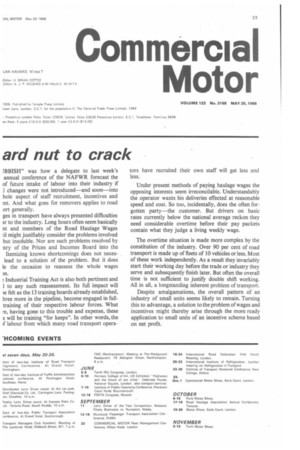ard nut to crack
Page 25

If you've noticed an error in this article please click here to report it so we can fix it.
IBBISH" was how a delegate to last week's annual conference of the NAFWR forecast the of future intake of labour into their industry if 1 changes were not introduced—and soon—into hole aspect of staff recruitment, incentives and !nt. And what goes for removers applies to road ort generally.
ges in transport have always presented difficulties ir to the industry. Long hours often seem basically nt and members of the Road Haulage Wages ;it might justifiably consider the problems involved but insoluble. Nor are such problems resolved by itry of the Prices and Incomes Board into the Itemizing known shortcomings does not neceslead to a solution of the problem. But it does le the occasion to reassess the whole wages Industrial Training Act is also both pertinent and I to any such reassessment. Its full impact will x felt as the 13 training boards already established, hree more in the pipeline, become engaged in fulltraining of their respective labour forces. What re, having gone to this trouble and expense, these s will be training "for keeps". In other words, the If labour from which many road transport opera tors have recruited their own staff will get less and less.
Under present methods of paying haulage wages the opposing interests seem irreconcilable. Understandably the operator wants his deliveries effected at reasonable speed and cost. So too, incidentally, does the often forgotten party—the customer. But drivers on basic rates currently below the national average reckon they need considerable overtime before their pay packets contain what they judge a living weekly wage.
The overtime situation is made more complex by the constitution of the industry. Over 90 per cent of road transport is made up of fleets of 10 vehicles or less. Most of these work independently. As a result they invariably start their working day before the trade or industry they serve and subsequently finish later. But often the overall time is not sufficient to justify double shift working. All in all, a longstanding inherent problem of transport.
Despite amalgamations, the overall pattern of an industry of small units seems likely to remain. Turning this to advantage, a solution to the problem of wages and incentives might thereby arise through the more ready application to small units of an incentive scheme based on net profit.




























































































































